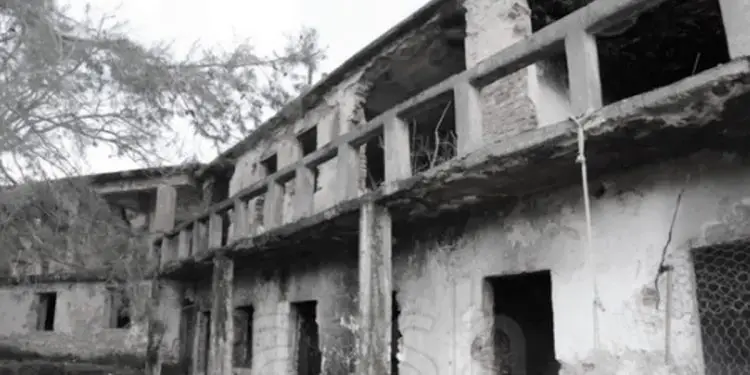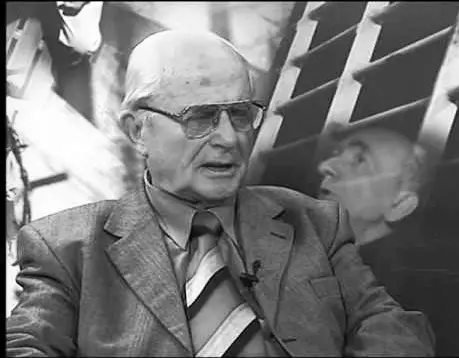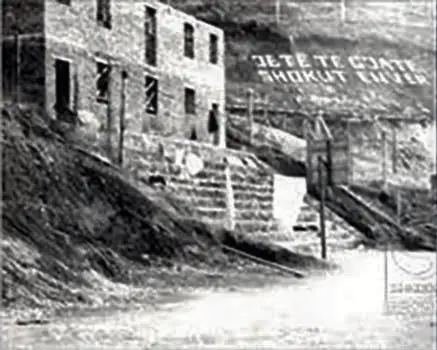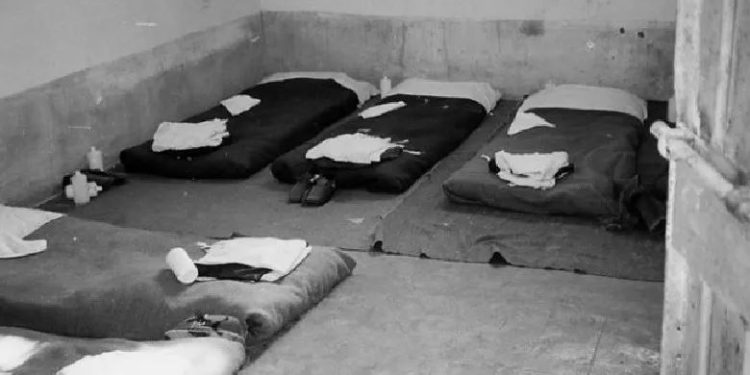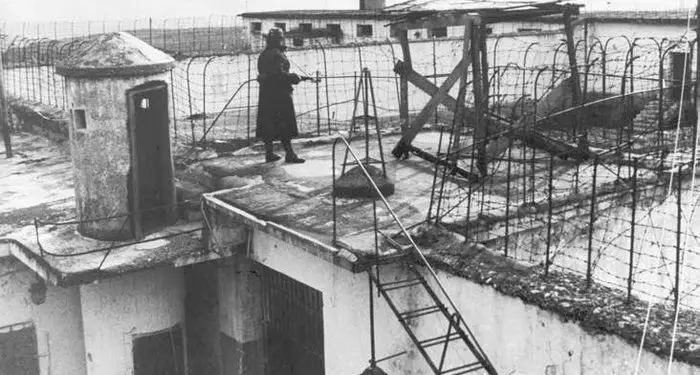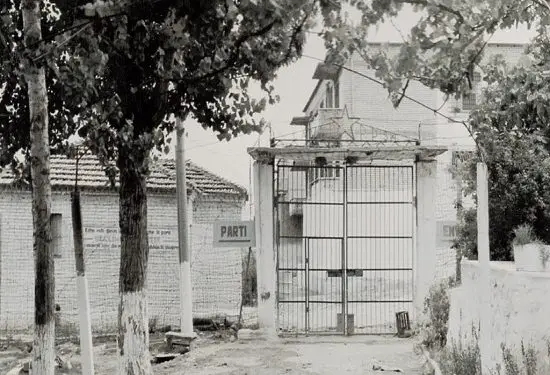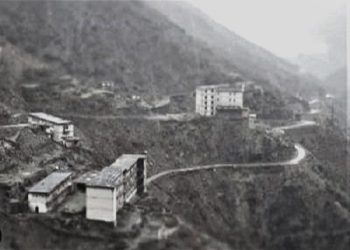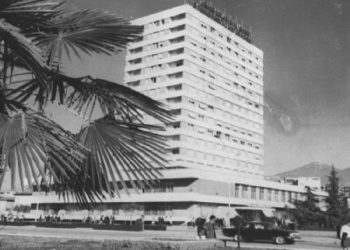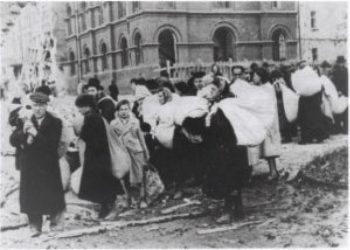From Agim Musta
The third part
Memorie.al / On the fourth anniversary of the passing away of the well-known historian, researcher, writer and publicist Agim Musta, (July 24, 2019), former political prisoner, his daughters Elizabeta and Suela, gave him the right to exclusivity for the publication, by the online media Memorie.al, of one of the author’s most prominent publications, such as the ‘Black Book of Albanian Communism’. This work contains numerous data, evidence, facts, statistics and arguments unknown to the general public, on communist crimes and terror in Albania, especially against intellectuals, in the period 1945-1991. The publication for the first time of parts of this book is also the realization of one of the bequests of the historian Agim Musta, who, from the beginning of 1991 until he passed away, for nearly three decades was engaged with all his powers, working to raise collective memory, through book publications and publications in the daily press. All that voluminous work of Mr. Agim Musta, concretized in several books, is a contribution of great value to the disclosure of the crimes of the communist regime of Enver Hoxha and his successor, Ramiz Alia. A good part of the publications of Mr. Agim Musta, is also translated into English. Thanking the two daughters of the late Musta, who chose Memorie.al, to commemorate their father, from today we are starting the publication, part by part, of the “Black Book of Albanian Communism”.
Continues from last issue
-The prisons of the Albanian communist state-
(1945-1991)
C) Camps with forced labor in agriculture and for the opening of terraces
With the deepening of the class war, with the attacks that were made against the elements that were declared enemies, with the “discovery of hostile groups”, in all areas of life activity carried out in Albania by the Party-State, the number of prisoners also increased from year to year. This was one of the reasons for setting up camps (prisons) with forced labor in agriculture, and especially for opening terraces, or performing various jobs on this front. And such camps were set up in several places such as:
- Torovica camp. This camp was built in the Torovica field, located to the left of the road on the farm, which was administered by the Ministry of Internal Affairs. About 500 political and ordinary prisoners were gathered in this camp, the vast majority of who were aged 14-18. It was said that the Torovica camp would become a model, as an “education” camp, but in fact it became the most notorious camp, for exhausting teenagers in heavy agricultural work, with a daily schedule of 10-11 hours of work.
Young people, who did not fulfill the daily norm, were barbarically beaten and tied to poles at the point of the sun. Due to grueling work, poor food and torture, many teenagers fell ill and some of them lost their lives. Many others were admitted to mental hospitals and remained insane for life. The youth camp of Torovica lacked a hygienic environment. The phenomena of immorality appeared there, such as pederasty. This camp existed for more than two decades, in the years 1969-1991.
- The camp of Zejmen. The Zejmen camp was built 8 km. in the south of the city of Lezha, in the village of Zejmen. About 700 political and ordinary prisoners over the age of 60, exhausted from many years of work and suffering from incurable diseases, were gathered in this camp. This camp was called “Camp before death”. Many sick people, for whom no medical attention was given, died in this camp. The prisoners, who were in a not very serious state of health, were taken out for agricultural work, to compensate the expenses of their sick fellow-sufferers. This camp existed until 1991.
- Valias camp. This is the first camp that was opened with political prisoners since 1945, 12 km. in the west of Tirana. The prisoners were housed in some old, former army barracks and worked for the land system of the agricultural farm of Kamza. The camp had strength of 400 people.
The prisoners worked for 12 hours a day, for opening canals and for the systematization of the field of Kamza. They were fed 600 grams of corn bread and given only 1 cup of drinking water per day. Those who did not fulfill the work norm were subjected to torture and were barbarically beaten. The prison camp was closed in 1946 and turned into a political internment camp.
- Camp of Belsh. This camp was set up near the town of Belshi (Elbasan) in 1957. In this camp there were political and ordinary prisoners aged 14-18. The effective number of the camp was about 300 people and most of the prisoners had minor sentences and came from communist families. Convicts worked in agriculture, but their treatment was more lenient than in other camps. This camp had a lifespan of 7 years. When the planned works were finished, the young people of this camp, distributed to other forced labor camps.
- Borsh camp. This camp was established in Borsh town of Saranda in 1966, with political prisoners. 1000 political and later ordinary prisoners were gathered in this camp. With the prisoners, the terracing of the mountains of the coast, from Himara to Saranda, with a length of 60 km., would be done in a mountainous terrain, all stones and bushes. Temperatures during the summer in the sun were scorching and dry the lips for a drop of water.
Food was very poor, but whoever was resourceful made up for it with the meat of turtles and hedgehogs, if they could sneak them into the camp. Many convicts died of exhaustion and diseases such as: pianist Rikard Riçi, Doctor Vojo Bilbilja, Sami Dangellia and others.
This camp was blown up by the brave Haxhi Sula, (originating from Tirana), who, after grabbing the machine gun from the guard’s hand, was able to leave in a car a few kilometers. He was caught seriously injured and re-sentenced to 25 years in prison. In 1981, the Borshi camp was moved further south, near the village of Shënvasi.
- Shenvasia or “Progress” camp. In 1981, the prison camp of Borsh, after finishing the terracing of the coastal mountains up to the vicinity of Lukovë township, was moved to a mountain gorge between Shënvasi and Hundecovë townships and was called Progress camp. The prisoners of this camp had the task of completing the terraces up to the Sixth Neck, 2 km east of the city of Saranda. The strength of the camp had reached up to 1300 prisoners. The work was even more difficult than in the Borshi camp.
The prisoners, exhausted from many years of work, no longer had the strength to work and achieve the standards required by the camp command. The bodies of the Ministry of Internal Affairs thought that; adding violence and torture, prisoners would do their best to meet the required standards. The guards addressed the unfortunates with the words; “Either the plan, or the soul”! (The soul). The convicts were beaten mercilessly, tied to poles, until they lost consciousness or went into nervous depression.
There have also been cases of death from torture. Calling the coastal terraces an achievement of the Party-State, Enver Hoxha was proud of these “Pearls of Socialist Albania”. Even a foreign delegation, visiting Albania at that time, was sent to see the coastal terraces, but always carefully hiding the prisoners. Thus the Greek Minister of Agriculture, who visited these plantations in 1985, called them; The “Albanian miracle”, but never talked about the slave labor that the prisoners did there.
In 1991, when Kristina Von Kohl of Denmark, a member of the Helsinki Committee, visited the forced labor camp of Progress, she stated: “The Nazi labor camps at Dachau and Mauthausen were far better than this camp that we saw here today”. Comments are redundant. This camp was closed on July 4, 1991.
Ç. Forced construction labor camps
Already in the first years of the establishment of the communist dictatorship, political and ordinary prisoners were used for the construction of social-cultural facilities and residential apartments. Below we are listing in chronological order the forced construction labor camps
- “Qemal Stafa” Stadium camp. During 1945, about 300 prisoners were taken out of Tirana’s prisons and accompanied by guards armed to the teeth, sent to work in the “Qemal Stafa” stadium, which the Italians had left unfinished. The working day was 10-12 hours. Those who did not fulfill the norm were beaten and isolated in cells. Work in this camp continued until April 1946.
- Camp no. 4 of Tirana. This camp had 600 political prisoners, who worked during the years 1952-1955 for the construction of the buildings of the “Agimi” Block in Tirana. Desperate for the violence and the long, hard work used in this camp, a group of prisoners tried to escape by opening a tunnel. Spyed by a provocateur, 20 people are arrested and with an investigator and accelerated trial, 4 people are sentenced to death and executed.
They were: Abdulla Bajrami, Mark Zefi, Isuf Velçani and Zyhdi Mancaku. Their execution took place in the yard of the Old Prison of Tirana, by the chief investigator of the Republic, General Nevzat Haznedari, cracking their skulls with an iron crowbar. Others were sentenced to heavy prison terms. After this event, all the prisoners of the camp were subjected to mass terror.
- “Dinamo” Stadium camp. During the time period 1955-1959, about 700 political and ordinary prisoners worked in this camp. Every day was worked with extended hours and three shifts. In this camp, two prisoners were killed who tried to escape and a free driver, Main Mezini, who crossed the forbidden line by 2 meters. Due to hard work and torture, there were also three suicides. Many prisoners fell ill, some died and others were permanently disabled.
- Sanatorium camp. In this camp, 2 km. in the east of Tirana, 350 political prisoners worked to build the largest sanatorium in Albania. The works began in 1960 and ended in early 1963. One prisoner lost his life due to lack of technical security and another committed suicide by jumping on the fence wire, where he was riddled with bullets from the soldiers guarding the camp.
- The “Puna” Block Camp. This camp was built on the left side of “Myslym Shyri” street, Tirana and had a workforce of 400 political prisoners. During the period 1960-1963, the prisoners of this camp built the “Puna” Block, with 500 residential apartments.Due to the lack of technical safety, there were many accidents during the work, 3 of which ended in death.
- “Dinamo” sports complex camp. This camp was built near the artificial lake of Tirana. 400 political prisoners worked here for a period of ten years (1977-1987). In addition to the Sports Complex “Dinamo”, the prisoners of this camp also built 300 residential apartments for the staff of the Ministry of Internal Affairs.
- Bona Bridge Camp. This camp was built near Beijing in 1950, with 700 political and ordinary prisoners. The prisoners of this camp built several km. track of the Peqin-Elbasan railway and many small bridges of this railway. At the end of 1950, this camp was moved to the vicinity of Bishqem village (Elbasan).
- Bishqem camp. Bishqem camp was built 15 km. west of the city of Elbasan with a force of 900 prisoners. The task of this camp was to open the railway tunnel of Bishqem, with a length of 400 meters. With primitive tools, without any technical insurance, the exhausted prisoners had to open the biggest tunnel in Albania. From the collapses in the tunnel, 27 people died and many others were left crippled for life. Worked in three shifts. From this camp, there were also escape attempts, some of which ended in the killing of the prisoners.
Note: In most districts of Albania, near the Departments of Internal Affairs, 20-30 prisoners, construction specialists, who still had to serve up to a year of imprisonment, were kept. These were used to build residential apartments for State Security and District Police personnel.
D) Forced labor camps for the construction of industrial works
During the period 1961-1975, with the help of Maoist China, which wanted to make Albania a communist, “Lightning Beacon in Europe”, a series of industrial works were built. Even for their construction, the work of political prisoners was used. For this purpose, a large number of prison camps were built, where convicts worked continuously in three shifts. We are listing these camps in chronological order, when work began on them.
- Camp of the Tirana Food Combine. This camp was built 2 km. in the southwest of Tirana, with an effective 400 political prisoners. The works for the construction of the “Food Factory” continued for three years, 1959-1962. During this time, the Bread Factory, the Beer Factory and several other factories were built, such as the Pasta, Jam, Fruit and Vegetable Canning, which all together made up the “Food Factory”.
- Tirana Meat and Milk Factory Camp. This camp, with an effective 300 political prisoners, during the period 1960-1963, built the Meat and Milk Factory in the northern suburbs of Tirana. In this camp, intensive work was done with three shifts.
- Rubik’s Camp. This camp was built near Rubik, on the banks of the Fan River. The object of the work of this camp, with a workforce of 400, was the construction of the Copper Smelting Plant. The works were led by Chinese engineers. The commander of the camp was Colonel Bajram Korvarfa, illiterate, extremely brutal and alcoholic, who tortured the prisoners with his hands.
In this camp, we worked intensively with three shifts. The works started in 1963 and ended in 1965. From this plant, when copper smelting began, 1 kg was extracted pure gold per day. There were also attempts to escape from Rubik’s camp. The young Demir Shkoza, who escaped from this camp, was captured near the district of Dibra, sentenced to death and executed.
- Camp of Laçi (Kurbin). In this camp, around 700 prisoners worked during the years 1963-1967, for the construction of the Phosphate Fertilizer Plant and the Sulfuric Acid Plant. At first, the prisoners built residential apartments in the city of Laç. In 1964, work began on the construction of the plant. In this camp, due to lack of technical security, eight prisoners died and three others, Naum Kondakçiu, Mark Cufi and Eqrem Zako, were killed after trying to escape.
The commander of that camp was Colonel Hazbi Lamçe, originally from Mallakastra, who was known as a close person of Mehmet Shehu, while the commissar was Nesti Ballta, originally from Korça. The works were directed by Chinese specialists, who behaved very correctly with the prisoners. In Laç, there have also been cases of suicide, such as that of the young Dibra Qerim Çaushi. Some others had serious accidents and were crippled for life, like Eqrem Çapaj, from the Duchy of Vlora.
- Fushë-Kruja camp. This camp was built 6 km. in the north-east of the town of Fushë-Kruja. About 700 political and ordinary prisoners were gathered here to build a cement factory. It worked in three shifts and the factory started production at the beginning of 1967. In the Fushë-Kruja camp, half of the bread ration was replaced with potatoes, which in most cases were spoiled. The hygienic conditions in this camp were very severe, the silos were narrow and old, and water was a “luxury”.
The commissar of the camp, Besnik Çomo, was known for his mischief, to make life as unbearable as possible for the convicts. In June 1966, the prisoners of this camp attempted to escape again. The convicts: Maksut Xhumaka (Babashi) and Ylli Tabaku, after blowing up the main gate of the camp with a hijacked truck, were able to get away a few hundred meters, but were caught and brutally beaten in the middle of the camp, until they lost consciousness. The court sentenced them to 5 years of additional imprisonment.
- Elbasan Cement Factory camp. This camp was located 3 km. in the north-west of the city of Elbasan, in the place called “Gropa e Teze”. Here, during the years 1967-1968, 1000 political prisoners worked for the construction of the cement factory, in extremely difficult sleeping conditions. On an area of 400 m2, 1000 convicts slept. The commander of the camp was Hysen Kapllanaj, (originally from Mallkastra), a strict man in the implementation of the regulation who tried to avoid confrontation with the prisoners. His opposite was the political commissar, Niko Kolitari, whom the prisoners nicknamed “Zgirbonja”.
In that man, his soul, his mind and his appearance, emanated only malice. In this camp, a 20-year-old boy, Mit’hat Allushi, and former teacher Reshat Ago committed suicide; and Ali Maliqi (originally from Peshkopia), was killed by the secret hand of the State Security, on the verge of release, after having suffered 23 years of imprisonment.
In this camp, due to the difficult hygienic conditions and very bad food, many convicts fell ill. There were also deaths due to lack of interest in treatment. Such is the case of Myzafer Demroç, 30 years old, who was taken to the hospital at the last moment of his life. / Memorie.al
The next issue follows




